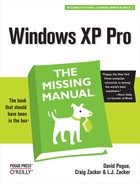A menu bar tops every Windows desktop window and almost every application window. Along this menu bar, of course, are the names of the menus that, when clicked, produce lists of the commands available to you.
Most menu bars have a menu named File on the extreme left side, and Help is always the last menu on the right. What comes between depends on the program you’re using. This appendix covers the menu commands in the Windows XP desktop windows.
Tip
You can choose almost any Windows XP menu command entirely from the keyboard; the necessary keystrokes are described in this appendix. (If you open a submenu that doesn’t bear the telltale keystroke-hint underlines, press the arrow keys to highlight the command you want, and then Enter to trigger it.)
If you open a menu and then change your mind, press the Esc key to close the menu.
Most of these commands operate on a selection—that is, you’re supposed to highlight an icon, or several icons, before using the menu. It’s worth noting, too, that the File menu changes depending on what you’ve highlighted. For example, you see one set of commands when you’ve highlighted an icon, and a longer set when nothing is selected.
Opens a highlighted document, program, folder, or disk into a window, exactly as though you had double-clicked its icon. (If Windows doesn’t know what program it’s supposed to use for opening a highlighted document, the command says Open With..., so that you can choose the program you want. And if you’ve highlighted a graphics file, the command says Preview instead of Open.) Keyboard equivalent: Enter.
Available for documents only. Sends the highlighted document to your printer after first opening the necessary application (such as your word processor) and offering you the Print dialog box, where you can specify, for example, how many copies you want. Keyboard equivalent: Alt+F, P.
Opens Windows Explorer, which shows you what’s in the highlighted disk or folder in the Explorer two-pane format (see Section 3.3.1 ). This command is available only if the selected icon is a drive or folder. Keyboard equivalent: Alt+F, X.
Opens a Search window that’s ready to look in the selected drive or folder (the Search command isn’t available if you select a file). See Section 1.7.5 for more on the Search command. Keyboard equivalent: F3.
Available only for folders and disks. Opens the Sharing tab of the icon’s Properties dialog box. As described in Chapter 20, this dialog box is exclusively for people with networks; it lets you make a folder or disk available to other people on the network. Keyboard equivalent: Alt+F, H.
Available for programs only, this handy command lets you run a program as though you have an Administrator account (or somebody else’s account), provided you know the account’s password. It’s described in Section 17.9 Keyboard equivalent: Highlight the program name, then press Alt+F, A.
Here’s another option for programs (and shortcuts of programs) only. It forces the highlighted icon to be listed in the top left section of your Start menu for easy access. Keyboard equivalent: Alt+F, I.
Offers submenu commands that move or copy the highlighted icon(s) to the desktop, to a floppy disk, to the My Documents folder, and so on. (For files and folders only.) Keyboard equivalent: Alt+F, N.
This command’s submenu lets you create a new folder, shortcut, text file, or other new item, depending on the programs you’ve installed. For example, if you have Microsoft Office installed, you’ll find a New→Microsoft Word Document command here. Keyboard equivalent: Alt+F, W.
Creates a shortcut to the selected icon. (See Section 3.4.3.1 for more on shortcuts.) If you’ve highlighted a folder or document icon, the shortcut appears in the same window as the original icon; at this point, you haven’t accomplished much. To make it useful, drag the shortcut to, for example, the desktop or the Quick Launch toolbar.
If the selected icon is a drive, Windows XP displays a message that says: “Windows cannot create a shortcut here. Do you want the shortcut to be placed on the desktop instead?” Click Yes. Keyboard equivalent: Alt+F, S.
Moves the highlighted folder or file to the Recycle bin, after first requesting confirmation. Keyboard equivalent: Delete or Ctrl+F, D.
Opens the Properties dialog box for the highlighted icon. Folder and file properties display creation-date and modification-date information. Disks display information about free and used space, along with a Tools tab that lets you open the disk-maintenance tools described in Chapter 16. If you’ve set up a network (Chapter 18), disk and folder Properties dialog boxes also offer a Sharing tab. Keyboard equivalent: Alt+Enter.
